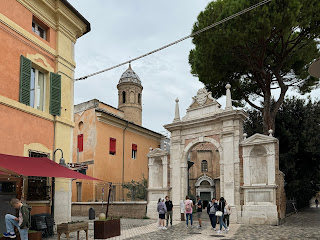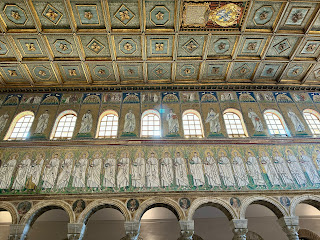The last day of our Italian swing gives us time to see a couple of sites in Ravenna before catching the train and then our afternoon flight from Bologna. Our plan saves one of the best sites for last: the Basilica di San Vitale (6th century).
We approach the church from the south and pass a large stone gate. We can see the 'front door' under the marble arch, but that is not the tourist entrance. Both the gate and the door seem to be Baroque era additions. We continue around several brick structures and enter from the northeast, between the large buttresses we saw yesterday.
The interior flow is vertical, but we are surprised by the lack of medieval mosaics; mostly, it's painted Baroque frescos. Triple-arched, two-story exedrae expand the, octagonal plan, and reach up to the overly-dramatic imagery in the center dome. Fragments of old floor mosaics hang within the ambulatory. The presbiterio extends to the southeast, and along its sides and in the apse, we find the mosaics.
Another visitor has her phone's flashlight on near the altar, so we wait for her to vacate. Meanwhile, we play with the iPhone's camera to see what the zoom lenses can do. The dome and the hall-domes of the exedrae are at least colorful. Several frescos are missing, and show how the church's flat surfaces are being manipulated by the Baroque painters. So while the Basilica's geometry is complex, the decorative elements take it to another level.
We see that the lady with the flashlight is reading her guidebook. We mention that her light is affecting everyone else's viewing and photography. She looks at us annoyed and goes on reading.
By contrast, the geometry in the presbiterio is straight forward: a double-height, cross-vaulted rectangular extension from the inner octagon ends at a single-story, semi-circular apse with a half-dome.
At the altar, the triumphal arch has a stack of intradosso, which resemble stone oculi. Classical dolphins with entwined tails separate the rings. There are fifteen images, seven on each side and Cristo Redentore over head. The portraits represent the Twelve Apostles plus two saint: Gerbasius and Protasius (thought to be the twin sons of San Vitale).
Just behind this arch, the ambulatory and the gallery end at stacked tripartite openings. Over the lower opening on the right (south) side is a lunette with the Offerta di Abel e Melchisedec, the lamb and the tithe to the Hand of God. Just above them, closer to the altar, is Mosè nel roveto ardente; he ties his sandal in the burning hills. On the opposite side, Isaias stands next a crown and prophesies the arrival of Christ. Next to the gallery opening are two of the Four Evangelists; above Mosè is St John with the symbolic angel, and opposite him is St Mark with the lion.
Over the lower opening on the left (east) side is a lunette with the Ospitalità di Abramo e Sacrificio di Isacco. On one side, three angles sit at a table as Abraham offers them a meal; on the other, God gives Abraham a sacrificial lamb, biting at his hem, in place of Isaac. Atop the lunette is Mosè sul Monte Sinai, as Mose receives the word from God. Opposite this, is Ieremia, another Old Testament prophet who foresees the events of Christ's life. The other two Evangelists are by the gallery opening; St John is above Ieremia with the eagle, and St Luke is above Mosè with the ox.
The edges of the arches have familiar red borders. These reach up to the vault, where they intersect with peacocks at the base of the diagonal ribs, and a flow of flowers, fruits, and fowl continues to the medallion at the top. This is supported by the four archangels, Michele, Gabriele, Raffaele, and Uriele; each stands on a blue orb and inhabits a brilliant field of swirling tendrils and animals. At the center, amongst white and gold stars, is L'Agnus Dei, the mystic lamb of God, looking tough and angry.
The half-dome of the altar is the Basilica's focal point. A young Jesus, attended by two archangels, sits on the universal sphere, and passes the crown of martyrdom to Scs Vitalis, on His right. While on His left, the bishop, Eclesius epis, holds the church. The Four Rivers of Paradise nourish the green landscape below the golden sky of heaven.
A tripartite window is centered below the half-dome, and on either side of the windows are two iconic mosaic panels. On the left (east) side is Giustiniano I, the Byzantine emperor who, in the mid-6th century, reclaims Ravenna from the Ostrogoths (Arianism). Joining him is Maximianus, the bishop whose cattedra (chair) is in the Museo Arcivescovile. On the right (south) side is the empress Teodora with her retinue of attendants, all bejeweled and finely dressed. Giustiniano and Teodora bear the paten and chalice for the Eucharist. These panels are pivotal in art history for the preservation of the Byzantine mosaics and the quality of the portraiture.
We make one more stop before our train, the Domus dei Tappeti di Pietra (house of stone carpets, 5th-6th centuries). The Domus is several meters below the Chiesa di Sant'Eufemia (18th century), discovered just thirty years ago during the construction of a parking garage. It consists of fourteen rooms with floor mosaics from the fifth and sixth centuries.
The signature pice of the Domus is the Danza dei Geni delle Quattro Stagioni (dance of the four seasons). Figures representing Primavera (left, in red with crown of roses), Inverno (top, wearing a dark cloak), Autunno (bottom, dressed in white) hold hands and dance, while Estate is in the missing potion of the mosaic. In the back, a musician plays the flauto di carne (pan flute).
Scattered about the incredible floor mosaics are Microobjects, an art show that is a collaboration between Fornice Objects (a company that makes 3D printed ceramics) and 'micromosaicista' Yuyu Zhao. Perhaps not quite as intriguing as the glass pieces in Padova, but still interesting and fun.
The last mosaic is the Buon Pastore (good shepherd), a male figure, casually crosses his legs, with two fawn and two large birds. The quality of the color is spectacular, and the shepherd's gesture to the deer is delightful.
We return to the Mercato Coperto and buy sandwiches for the train ride. The quality of the food in Emilia-Romagno is unmatched; even the sandwiches are special. The logistics of transferring to the airport train (Marconi Express) are painless, and we are soon flying home. We edit our photos and relive the trip.
(UPDATE, November 5): The iPhone 15 Pro Max survives the trip, and proves to be a true asset. Photos taken with both the main camera (with 24MP resolution) and the telephoto (with 120mm focal length) give amazing detail. We see things we previously missed, which is the whole point of the upgrade.
The Fine Woven Case, much maligned by the tech press is definitely showing wear, especially at the bottom where it rubs on the seam of the jeans pocket (but it did protect the phone when it fell near Sant'Apollinare Nuovo – note the scratch and dimple in the lower right).
Thanks to our niece for the delivery.



























































































































